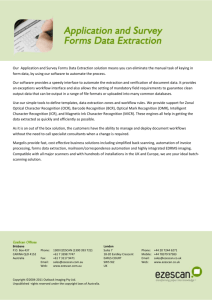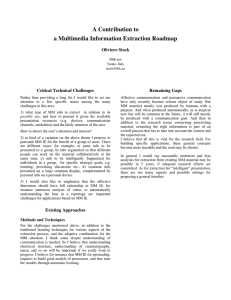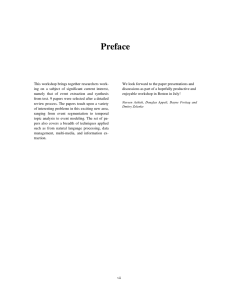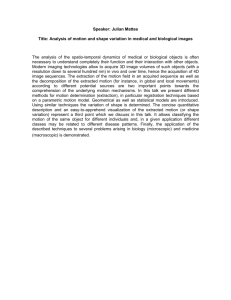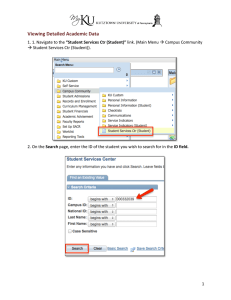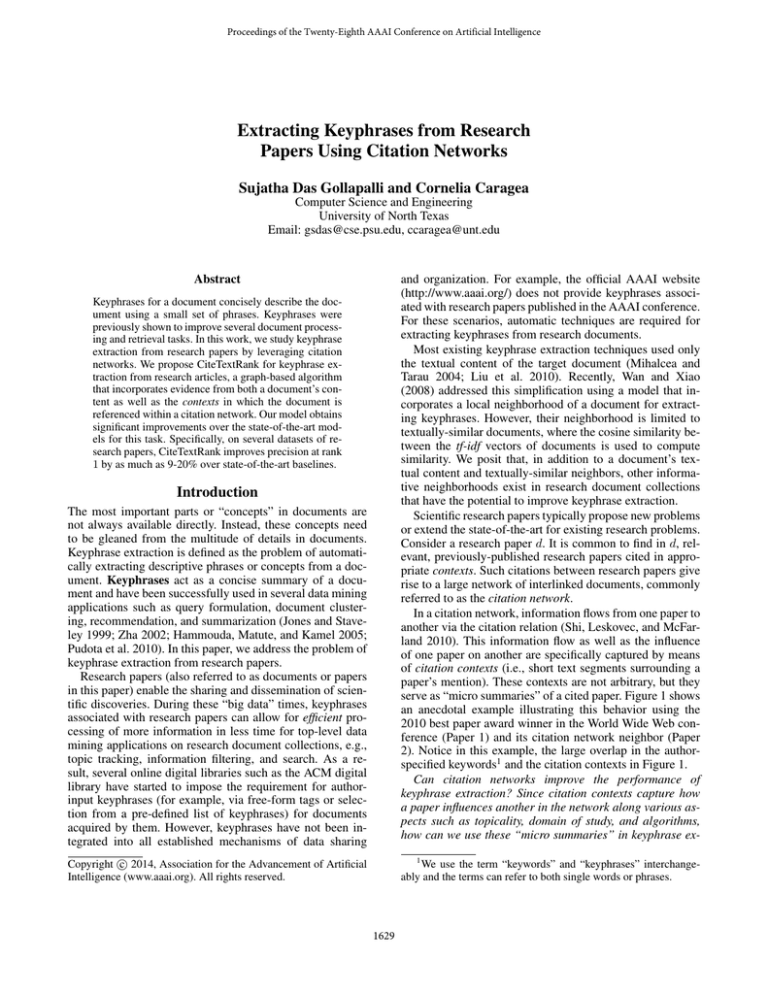
Proceedings of the Twenty-Eighth AAAI Conference on Artificial Intelligence
Extracting Keyphrases from Research
Papers Using Citation Networks
Sujatha Das Gollapalli and Cornelia Caragea
Computer Science and Engineering
University of North Texas
Email: gsdas@cse.psu.edu, ccaragea@unt.edu
Abstract
and organization. For example, the official AAAI website
(http://www.aaai.org/) does not provide keyphrases associated with research papers published in the AAAI conference.
For these scenarios, automatic techniques are required for
extracting keyphrases from research documents.
Most existing keyphrase extraction techniques used only
the textual content of the target document (Mihalcea and
Tarau 2004; Liu et al. 2010). Recently, Wan and Xiao
(2008) addressed this simplification using a model that incorporates a local neighborhood of a document for extracting keyphrases. However, their neighborhood is limited to
textually-similar documents, where the cosine similarity between the tf-idf vectors of documents is used to compute
similarity. We posit that, in addition to a document’s textual content and textually-similar neighbors, other informative neighborhoods exist in research document collections
that have the potential to improve keyphrase extraction.
Scientific research papers typically propose new problems
or extend the state-of-the-art for existing research problems.
Consider a research paper d. It is common to find in d, relevant, previously-published research papers cited in appropriate contexts. Such citations between research papers give
rise to a large network of interlinked documents, commonly
referred to as the citation network.
In a citation network, information flows from one paper to
another via the citation relation (Shi, Leskovec, and McFarland 2010). This information flow as well as the influence
of one paper on another are specifically captured by means
of citation contexts (i.e., short text segments surrounding a
paper’s mention). These contexts are not arbitrary, but they
serve as “micro summaries” of a cited paper. Figure 1 shows
an anecdotal example illustrating this behavior using the
2010 best paper award winner in the World Wide Web conference (Paper 1) and its citation network neighbor (Paper
2). Notice in this example, the large overlap in the authorspecified keywords1 and the citation contexts in Figure 1.
Can citation networks improve the performance of
keyphrase extraction? Since citation contexts capture how
a paper influences another in the network along various aspects such as topicality, domain of study, and algorithms,
how can we use these “micro summaries” in keyphrase ex-
Keyphrases for a document concisely describe the document using a small set of phrases. Keyphrases were
previously shown to improve several document processing and retrieval tasks. In this work, we study keyphrase
extraction from research papers by leveraging citation
networks. We propose CiteTextRank for keyphrase extraction from research articles, a graph-based algorithm
that incorporates evidence from both a document’s content as well as the contexts in which the document is
referenced within a citation network. Our model obtains
significant improvements over the state-of-the-art models for this task. Specifically, on several datasets of research papers, CiteTextRank improves precision at rank
1 by as much as 9-20% over state-of-the-art baselines.
Introduction
The most important parts or “concepts” in documents are
not always available directly. Instead, these concepts need
to be gleaned from the multitude of details in documents.
Keyphrase extraction is defined as the problem of automatically extracting descriptive phrases or concepts from a document. Keyphrases act as a concise summary of a document and have been successfully used in several data mining
applications such as query formulation, document clustering, recommendation, and summarization (Jones and Staveley 1999; Zha 2002; Hammouda, Matute, and Kamel 2005;
Pudota et al. 2010). In this paper, we address the problem of
keyphrase extraction from research papers.
Research papers (also referred to as documents or papers
in this paper) enable the sharing and dissemination of scientific discoveries. During these “big data” times, keyphrases
associated with research papers can allow for efficient processing of more information in less time for top-level data
mining applications on research document collections, e.g.,
topic tracking, information filtering, and search. As a result, several online digital libraries such as the ACM digital
library have started to impose the requirement for authorinput keyphrases (for example, via free-form tags or selection from a pre-defined list of keyphrases) for documents
acquired by them. However, keyphrases have not been integrated into all established mechanisms of data sharing
1
We use the term “keywords” and “keyphrases” interchangeably and the terms can refer to both single words or phrases.
c 2014, Association for the Advancement of Artificial
Copyright Intelligence (www.aaai.org). All rights reserved.
1629
Figure 1: A small citation network.
traction models? We specifically address these questions
with our research agenda in this paper.
Our contributions are as follows:
1. We propose a novel approach to keyphrase extraction
from scientific documents using the citation network information. In particular, we effectively leverage the contexts in which a document is referenced in citation networks for extracting keyphrases.
2. We design CiteTextRank, a fully unsupervised graphbased algorithm that incorporates evidence from multiple
sources (citation contexts as well as document content) in
a flexible manner to score keywords that are later used to
score keyphrases.
3. We experimentally validate CiteTextRank on several
representative datasets and show statistically significant
improvements over existing state-of-the-art models for
keyphrase extraction.
4. Additionally, as part of our contributions, we created three
representative datasets that will be made available to further research in the keyphrase extraction community.
Our research hypothesis and motivation were just presented
in this section. In the following section, we briefly summarize related, state-of-the-art approaches to keyphrase extraction. CiteTextRank is described in detail in the “Proposed
Model” section. Finally, we present our datasets, experiments and results before concluding the paper.
such as term frequencies, inverse document frequencies,
topic proportions, etc. are used to score terms in a document
that are later aggregated to obtain scores for phrases (Mihalcea and Tarau 2004; Liu et al. 2010; Boudin 2013).
The PageRank algorithm is widely-used in keyphrase extraction models. Other centrality measures such as betweenness and degree centrality were also previously studied for
keyphrase extraction (Palshikar 2007). However, based on
recent experiments in (Kim et al. 2013; Kim and Kan 2009)
and (Boudin 2013), the PageRank family of methods and
tf-idf based scoring can be considered the state-of-the-art for
unsupervised keyphrase extraction.
Mihalcea and Tarau (2004), were the first to propose TextRank, for scoring keyphrases using the PageRank values
obtained on a word graph built from the adjacent words in
a document. Wan and Xiao (2008) extended the TextRank
approach to SingleRank by adding edges between words
within a window size greater than 2 and edge weights in the
graph based on co-occurrence between words. Unlike the
TextRank and SingleRank models, where only the content
of the target document are used for keyphrase extraction,
textually-similar neighboring documents are included in the
scoring process in ExpandRank (Wan and Xiao 2008).
In contrast to the approaches above, we present a model
for keyphrase extraction from research papers that are embedded in citation networks. The underlying algorithm of
our model is PageRank applied to word graphs constructed
from target papers and their local neighborhood in a citation
network. In addition, unlike the approaches so far, our model
incorporates multiple neighborhoods and includes a flexible
way to incorporate different weights for each neighborhood.
Recently, social tagging has been prevalent in Web 2.0
applications. Similar to keyphrase extraction, tag recommendation systems are designed to predict descriptive terms
or tags for organizing and sharing Web resources. However, in contrast with our problem setup, most of these
systems are designed for web objects that also have nontextual content. In addition, previous behavior of users in
interactions with these objects can be used for recommending tags (Song, Zhang, and Giles 2008; Rendle et al. 2009;
Yin et al. 2010). Due to these differences, we do not discuss
Related work
Keyphrase extraction was previously studied using both supervised and unsupervised techniques for different types
of documents including scientific abstracts, newswire documents, meeting transcripts, and webpages (Frank et al. 1999;
Hulth 2003; Nguyen and Kan 2007; Liu et al. 2009; Marujo
et al. 2013). The recent SemEval 2010 Shared Task was focused on comparing keyphrase extraction systems for scientific articles (Kim et al. 2010; 2013), indicating once again
the significance of this problem.
Supervised techniques use annotated documents with
“correct” keyphrases to train classifiers for discriminating
keyphrases extracted from a document (Frank et al. 1999;
Turney 2000; Hulth 2003). In unsupervised keyphrase extraction, domain-specific knowledge and various measures
1630
frequency of words corresponding to vi and vj in context
c; Ct is the set of contexts of type t ∈ T ; and λt is the
weight for contexts of type t.
Finally, we score the vertices in G (and the corresponding candidate words) using the PageRank algorithm (Page
et al. 1999). That is, the score s for vertex vi is obtained by
recursively computing the equation:
X
wji
P
s(vi ) = (1 − α) + α
s(vj ) (2)
vk ∈Adj(vj ) wjk
tag recommendation further.
Proposed Model
Preliminaries
Definition 1 (Keyphrase Extraction) Given a target document d, the objective of the keyphrase extraction task is to
extract a ranked list of candidate words or phrases from d
that best represent d.
Algorithms for unsupervised keyphrase extraction commonly involve three steps (Hasan and Ng 2010):
vj ∈Adj(vi )
1. Candidate words or lexical units are extracted from the
textual content of the target document by applying stopword and parts-of-speech filters. Only noun and adjectives
that are likely to be keyphrases are retained in this step.
2. Next, candidate words are scored based on some criterion.
For example, in the TFIDF scoring scheme, a candidate
word score is the product of its frequency in the document
and its inverse document frequency in the collection.
3. Finally, consecutive words, phrases or n-grams are scored
by using the sum of scores of individual words that comprise the phrase (Wan and Xiao 2008). The top-scoring
phrases are output as predictions (the keyphrases for the
document).
where α is the damping factor typically set to 0.85 (Haveliwala et al. 2003).
Unlike simple graph edges with fixed weights, notice that
our equations correspond to parameterized edge weights.
We incorporate the notion of “importance” of contexts of a
certain type using the λt parameters. For instance, one might
assign higher importance to citation contexts over global
contexts, or cited over citing contexts. One way to visualize our edges is to imagine the two vertices in the underlying graph to be connected using multiple edges of different types. For example, in Figure 2, the two edges between
“logic” and “programming” could correspond to cited and
global contexts respectively.
In what follows, we describe CiteTextRank (CTR), our
fully unsupervised, graph-based model that explicitly incorporates information from citation contexts while scoring
candidate words in step (2).
CiteTextRank
Let d be the target document for keyphrase extraction and C
be a citation network such that d ∈ C.
Definition 2 (Contexts) A cited context for document d is
defined as a context in which d is cited by some paper di in
the network. A citing context for d is defined as a context in
which d is citing some paper dj in the network. The content
of d comprises its global context.
If a document d1 cites a document d2 in multiple contexts,
then we aggregate all such contexts and simply refer to them
as the citing or cited context (as applicable).
Let T represent the types of available contexts for d.
These types include the global context of d, Nd Ctd , the set of
cited contexts for d, Nd Ctg , the set of citing contexts for d,
and textually-similar global contexts, Nd Sim . We construct
an undirected graph, G = (V, E) for d as follows:
Figure 2: A small word graph. We show the edges added due
to different context types using different colors/line-styles
Intuitively, a context that is more similar to the target document should be assigned higher weight during keyphrase
extraction. In addition, we would like to score edges between word pairs that co-occur frequently higher than those
that co-occur rarely. These two aspects are captured by the
cosine similarity and co-occurrence components in the edge
weights of Equation (1).
The vertices in G can be scored using any graph
centrality-based measures. However, PageRank models
were shown to be state-of-the-art in previous research involving word graphs for keyphrase extraction (Mihalcea and
Tarau 2004; Liu et al. 2010; Boudin 2013). In particular, the
PageRank score for a node (or vertex) provides a measure
of importance for the node in the graph by taking into account global information computed recursively from the entire graph (Brin and Page 1998; Haveliwala et al. 2003).
PageRank uses the notion of “voting” between vertices to
assign “importance” scores for vertices (Page et al. 1999).
If a node links to another one, it is casting a vote to that
other node. Nodes recursively cast votes across their links,
where the votes are weighted by the current estimate of their
1. For each unique candidate word extracted from all available contexts of d, add a vertex in G.
2. Add an undirected edge between two vertices vi and vj if
the words corresponding to these vertices occur within a
window of w contiguous tokens in any of the contexts.
3. The weight wij of an edge (vi , vj ) ∈ E is given as
XX
wij = wji =
λt · cossim(c, d) · #c (vi , vj ) (1)
t∈T c∈Ct
where cossim(c, d) is the cosine similarity between the tfidf vectors of any context c of d and d (Manning, Raghavan, and Schütze 2008); #c (vi , vj ) is the co-occurrence
1631
Conference
AAAI
UMD
WWW
KDD
#Titles(Org)
5676
490
2936
1829
#Titles(CiteSeer)
2424
439
1350
834
#Queries
93
163
406
335
AvgKeywords
4.15
3.93
4.81
4.09
AvgCitingContexts
9.77
20.15
15.91
18.85
AvgCitedContexts
13.95
34.65
17.39
16.82
Table 1: Summary of datasets, #Queries represent the number of documents for which both citing, cited contexts were extracted
from CiteSeer and for which the “correct” keyphrases are available. All datasets are available upon request.
KDD
WWW
0.36
UMD
0.32
0.2
0.19
0.34
0.3
0.18
0.32
0.3
0.16
0.26
0.24
0.26
MRR
MRR
0.28
MRR
0.17
0.28
0.24
0.15
0.14
0.13
0.22
0.22
{10,1,3,3,2}
{3,1,2,2,1}
{7,1,1,1,1}
{1,3,1,3,3}
0.2
0.18
0.16
1
2
3
4
5
6
7
8
0.12
{10,1,1,3,1}
{1,1,3,3,3}
{5,2,2,3,1}
{4,1,1,1,2}
0.2
0.18
9
10
1
2
3
K
4
5
6
7
K
8
{7, 3,1,3,1}
{7,2,1,2,1}
{1,1,3,1,1}
{5,3,1,2,1}
0.11
0.1
0.09
9
10
1
2
3
4
5
6
7
8
9
10
K
Figure 3: Parameter tuning for CiteTextRank. Sample configurations are shown. Setting {a,b,c,d,e} indicates that the window
parameter is set to ‘a’ with ‘b’, ‘c’, ‘d’, ‘e’ as weights for textually-similar neighbors, cited, citing, and global contexts of a
document, respectively.
For all datasets, we used paper titles to query the CiteSeerX3 digital library (Giles, Bollacker, and Lawrence 1998)
and retrieve their corresponding pdf documents, as well as
the cited and citing contexts for each document. We collected the titles of all papers published in KDD and WWW
directly from these conferences’ websites. From all pdf documents found in CiteSeerX, we retained in our datasets only
those for which we were able to extract the abstract and
the author-input keywords (from the Keywords field). These
keywords represent the gold-standard for evaluation.
In addition, we evaluated CTR for keyword extraction
from papers published in the previous years of AAAI4 . We
adopted the same procedure that was used to create our other
datasets to obtain the citation network for AAAI papers.
However, since author-specified keywords are not available
with AAAI papers, we manually examined and annotated
about 100 randomly selected AAAI papers with keywords.
Our datasets are summarized in Table 1. This table shows
the original number of titles in each collection along with
the number of titles we were able to map to CiteSeerX documents using title search. The number of documents having
cited and citing contexts and abstracts as well as the average
numbers of keywords, citing, and cited contexts are listed in
this table. On average, authors describe a given research paper with a small set of 3-5 keywords making it a challenging
task to rank the appropriate keywords in the top positions.
Context lengths. We used citation contexts of papers as obtained from CiteSeerX directly. CiteSeerX provides a context of 50 words on each side of a citation mention in a paper. According to a previous study on the impact of various citation context length on information retrieval tasks by
nodes’ PageRank. Hence, the score associated with a vertex depends on the number of votes that are cast for it, as
well as the importance of nodes casting these votes (Brin and
Page 1998). For graphs where vertices correspond to words,
PageRank scores therefore capture the intuition that a word
is important if it is linked to many words, some of which are
important as well.
In CiteTextRank, unlike other PageRank-based keyphrase
extraction models (Mihalcea and Tarau 2004; Wan and Xiao
2008), we build the graph for computing scores using information from multiple contexts. Moreover, the λt parameters
provide means to tune the importance of each type of context. We now experimentally show that CTR effectively captures the notion of word importance across multiple global
and citation contexts.
Experiments
Datasets and evaluation measures
Existing benchmark datasets for keyword extraction do not
contain citation network information (Hulth 2003; Hasan
and Ng 2010; Kim et al. 2010). In order to test the performance of CiteTextRank, we need gold-standard annotated
datasets of research papers and their associated citation networks. We constructed three such datasets. The first two are
proceedings of the last ten years of: (1) the ACM Conference
on Knowledge Discovery and Data Mining (KDD), and (2)
the World Wide Web Conference (WWW). The third dataset
(referred to as UMD in this paper) was made available by
Lise Getoor’s research group at the University of Maryland2 .
This dataset was previously used to study document classification (Lu and Getoor 2003) and citation recommendation (Kataria, Mitra, and Bhatia 2010).
2
3
4
http://www.cs.umd.edu/∼sen/lbc-proj/LBC.html
1632
http://citeseerx.ist.psu.edu
http://www.aaai.org/Library/AAAI/aaai-library.php
KDD
WWW
0.36
0.34
0.2
0.3
0.32
0.18
0.28
0.3
0.16
0.26
MRR
0.26
0.28
MRR
MRR
UMD
0.32
0.24
0.22
0.24
CTR
CTR(Ctg)
CTR(Ctd)
SR
ER
0.22
0.2
0.18
1
2
3
4
5
6
7
8
0.12
CTR
CTR(Ctg)
CTR(Ctd)
SR
ER
0.2
0.18
0.16
9
10
0.14
1
2
3
K
4
5
6
K
7
8
CTR
CTR(Ctg)
CTR(Ctd)
SR
ER
0.1
0.08
9
10
1
2
3
4
5
6
7
8
9
10
K
Figure 4: Effect of citation network information on keyphrase extraction. CiteTextRank (CTR) that uses citation network neighbors is compared with ExpandRank (ER) that uses textually-similar neighbors and SingleRank (SR) that only uses the target
document content.
Values 1-10 were tested for each parameter in steps of
1. The varying performance of CTR with different λt parameters illustrate the flexibility that CTR permits in treating each type of evidence differently. For example, to score
keyphrases based on global context alone, we can set the λt
values corresponding to the other contexts to zero.
Other types of neighborhoods can be included into the
CTR model by appropriately extending the edge weights
(Eq. (1)). We experimented with including the global contexts of citing and cited documents in the citation network.
However, these global contexts did not provide additional
improvements over citing and cited contexts. We do not include these experiments due to space restrictions.
How well does citation network information aid in key
phrase extraction for research papers? Figure 4 shows
MRR plots comparing CTR with SingleRank (SR) and ExpandRank (ER) on different datasets. In SR, edges are added
between candidate word nodes if they occur within a window of w words of each other in the target document.
Textually-similar neighbors are also considered in the ER
model. Thus, window size w is a parameter for both SR and
ER whereas the number of textually-similar neighbors is a
parameter for ER. For CTR experiments, we include all citation network neighbors that are available. For each dataset
and model (SR, ER, and CTR), we tested parameter values
in steps of 1 in the range 1-10 and chose the best-performing
settings in the comparison experiments presented in Figure 4. The “best-performing setting” corresponds to the setting that gives the highest MRR at average k for that dataset.
As can be seen in Figure 4, CTR substantially outperforms both SR and ER, illustrating that the cited and citing contexts contain significant hints that aid keyphrase extraction in addition to a document’s content or its textuallysimilar documents. CTR is able to harness this evidence successfully to obtain good improvements in the extraction performance. For instance, compared to SR that uses document
content alone, using CTR that incorporates multiple contexts
and best-performing λt values, we achieve MRR@average
k improvements of 28.66% for UMD, 23.73% for KDD, and
12.20% for the WWW datasets.
Figure 4 also shows MRR plots comparing CTR models when: (1) all the contexts for a document are used, the
full CTR model; (2) only cited contexts are used, denoted
Ritchie (2008), a fixed window length of about 100 words
was found to be effective in general. Accurate extraction and
categorization of citation contexts is a subject of current research (Teufel 1999; Abu-Jbara and Radev 2012) and we
plan to study the effect of context lengths on keyphrase extraction in future. For the global context of a document, we
use its title and abstract. The choice of not considering the
entire text is due to the observation that scientific papers contain details such as discussion of results, experimental design, and notation that do not provide additional benefits for
extracting keyphrases. Therefore, similar to previous works,
we do not use the entire text (Mihalcea and Tarau 2004;
Hulth 2003).
Evaluation measures. As in previous works, we use the
measures: precision, recall, F1, and mean reciprocal rank
(MRR) for evaluating our model (Manning, Raghavan, and
Schütze 2008). In particular, we use MRR curves to illustrate
our experimental findings. MRR is a standard measure used
in ranked retrieval tasks that gives the averaged ranking
P of
1
1
the first correct prediction. That is, M RR = |Q|
rq
q=1...|Q|
where rq refers to the rank at which the first correct prediction was found for query q ∈ Q (here Q is the set of
target documents). For computing “@k” numbers (such as
MRR@k), we only examine the top-k predictions. We use
average k to refer to the average number of keywords for a
particular dataset as listed in Table 1. For example, average
k = 5 for the WWW dataset.
Results and Observations
Our experiments are organized around several questions as
detailed below.
How sensitive is CiteTextRank to its parameters? CTR
has two sets of parameters, the window size w that determines how the edges are added between candidate word
nodes in the graph and the λt values that determine the
weight of each context type. To illustrate the effect of parameters in the CiteTextRank model, we randomly chose a
few top-performing and not-so-well performing parameter
configurations (w and λt values) from our parameter sweep
experiments and plot them in Figure 3. Changing the λt values corresponds to assigning different weights to the global
context, neighbors based on content similarity, and citing
and cited contexts for a document.
1633
KDD
WWW
0.4
0.35
UMD
0.32
0.2
0.3
0.18
0.28
0.16
0.26
0.3
0.14
0.25
MRR
MRR
MRR
0.24
0.22
0.2
0.2
0.12
0.1
0.18
0.08
CTR
ER
TR
TFIDF
0.15
CTR
ER
TR
TFIDF
0.16
0.14
0.1
0.12
1
2
3
4
5
6
7
8
9
10
CTR
ER
TR
TFIDF
0.06
0.04
1
2
3
K
4
5
6
7
8
9
10
1
2
3
4
K
5
6
7
8
9
10
K
Figure 5: MRR curves for different keyphrase extraction methods. CiteTextRank (CTR) is compared with the baselines: TFIDF,
TextRank (TR), and ExpandRank (ER).
1
2
3
COD: Online Temporal Clustering for Outbreak Detection (2007)
{outbreak detection, onset detection, detection task, epidemic outbreaks}
Temporal Clustering, Outbreak Detection, Cluster Onset Detection, unsupervised learning
Mixed Constraint Satisfaction: A Framework for Decision Problems under Incomplete Knowledge (1996)
{constraint satisfaction, knowledge constraint, mixed constraint, csp framework}
Mixed Constraint satisfaction, CSP framework, incomplete knowledge, mixed CSP
Recent Developments in NIKL (1986)
{knowledge representation, representation languages, kl-one family, nikl}
KL-ONE, knowledge representation, NIKL
Table 2: Sample predictions for AAAI papers using CiteTextRank. Human-picked keyphrases are shown in bold.
CTR(Ctd); and (3) only citing contexts are used, denoted
CTR(Ctg). The motivation for this comparison was to determine how well the proposed model performs on newlypublished research papers that often accumulate citations
not immediately, but over a period of time. Thus, these papers usually lack neighbors that cite them in the citation network although the neighbors they cite are available. As can
be seen in the figure, CTR(Ctd) generally performs slightly
better than CTR(Ctg), with both of them substantially outperforming SR and ER. The full CTR model performs best
among all compared models in the figure.
How does CiteTextRank compare with existing state-ofthe-art methods? Figure 5 shows MRR plots comparing
CTR with the baselines: TFIDF, TextRank (TR), and ExpandRank (ER). Based on recent studies, these baselines
comprise state-of-the-art for keyphrase extraction (Mihalcea
and Tarau 2004; Wan and Xiao 2008; Hasan and Ng 2010).
As the plots in Figure 5 indicate, CTR substantially outperforms other keyphrase extraction models. Similar results
hold for precision and recall plots (results not shown due to
space limitations). With a paired T-test, our improvements
for MRR, precision and recall are statistically significant for
p-values ≥ 0.05. Finally, we compare the best-performing
baseline from previous research with CTR at average k in
Table 3. CTR effectively out-performs the state-of-the-art
baseline models for keyphrase extraction.
How does CiteTextRank perform on AAAI papers? Using CiteTextRank, we obtained precision and recall values
of 22.8% and 27%, respectively, on the AAAI dataset along
with an MRR value of 0.50 at k = 4. That is, on average,
we are able to predict the gold-standard keyphrase at rank 2
among the top-4 predictions. We show some anecdotal ex-
amples in Table 2. The predictions obtained by CTR along
with human-picked “gold” keyphrases are listed in this table.
As can be seen, there is a high overlap between the “gold”
and predicted keyword sets.
Dataset
UMD
WWW
KDD
Method
BL∗
CTR
BL∗
CTR
BL∗
CTR
Precision
0.0844
0.0905
0.1000
0.1099
0.1052
0.1328
Recall
0.0956
0.0925
0.1220
0.1341
0.1219
0.1529
F1
0.0871
0.0914
0.1085
0.1192
0.1116
0.1405
MRR
0.1610
0.1769
0.2566
0.2878
0.2858
0.3348
Table 3: The evaluation measures at average k are shown for
the best baseline method (BL∗ ) and CiteTextRank (CTR).
Conclusions and Future Directions
We addressed keyphrase extraction from scientific documents. In particular, we showed that in addition to the original textual content of a scientific document, the fact that the
document is situated in an interlinked citation network can
be effectively harnessed for extracting keyphrases. We proposed CiteTextRank (CTR), a flexible, unsupervised graphbased model for ranking keyphrases using multiple sources
of evidence such as the textual content of a document,
textually-similar neighbors and neighbors in the interlinked
document citation network. Using CTR, we illustrated significant improvements over baseline models for multiple
datasets of research papers in the Computer Science domain.
Unlike CTR, the baseline models are more general since
they depend only on the document content and textuallysimilar neighbors. However, we believe that CTR will ben-
1634
Liu, Z.; Huang, W.; Zheng, Y.; and Sun, M. 2010. Automatic
keyphrase extraction via topic decomposition. In EMNLP.
Lu, Q., and Getoor, L. 2003. Link-based classification. In
ICML.
Manning, C. D.; Raghavan, P.; and Schütze, H. 2008. Introduction to Information Retrieval. Cambridge University
Press.
Marujo, L.; Ribeiro, R.; de Matos, D. M.; Neto, J. P.; Gershman, A.; and Carbonell, J. G. 2013. Key phrase extraction
of lightly filtered broadcast news. CoRR.
Mihalcea, R., and Tarau, P. 2004. Textrank: Bringing order
into text. In EMNLP.
Nguyen, T., and Kan, M.-Y. 2007. Keyphrase extraction in
scientific publications. In Asian Digital Libraries. Looking
Back 10 Years and Forging New Frontiers, volume 4822.
Page, L.; Brin, S.; Motwani, R.; and Winograd, T. 1999.
The pagerank citation ranking: Bringing order to the web.
Technical report.
Palshikar, G. K. 2007. Keyword extraction from a single
document using centrality measures. In International Conference on Pattern Recognition and Machine Intelligence.
Pudota, N.; Dattolo, A.; Baruzzo, A.; Ferrara, F.; and Tasso,
C. 2010. Automatic keyphrase extraction and ontology mining for content-based tag recommendation. Int. J. Intell.
Syst.
Rendle, S.; Balby Marinho, L.; Nanopoulos, A.; and
Schmidt-Thieme, L. 2009. Learning optimal ranking with
tensor factorization for tag recommendation. In KDD.
Ritchie, A. 2008. Citation context analysis for information
retrieval. Ph.D. Dissertation, University of Cambridge.
Shi, X.; Leskovec, J.; and McFarland, D. A. 2010. Citing
for high impact. In JCDL.
Song, Y.; Zhang, L.; and Giles, C. L. 2008. A sparse gaussian processes classification framework for fast tag suggestions. In CIKM.
Teufel, S. 1999. Argumentative Zoning: Information Extraction from Scientific Text. Ph.D. Dissertation, University
of Edinburgh,.
Turney, P. D. 2000. Learning algorithms for keyphrase extraction. Inf. Retr. 2.
Wan, X., and Xiao, J. 2008. Single document keyphrase
extraction using neighborhood knowledge. In AAAI.
Yin, D.; Xue, Z.; Hong, L.; and Davison, B. D. 2010. A
probabilistic model for personalized tag prediction. In KDD.
Zha, H. 2002. Generic summarization and keyphrase extraction using mutual reinforcement principle and sentence
clustering. In SIGIR.
efit scenarios where additional evidence is available from
highly-connected networks that can help improve keyphrase
extraction. Examples of such scenarios include papers from
domains other than Computer Science, e.g., Biology and
Chemistry, webpages or images on the Web (where the anchor texts pointing to a webpage or to an image act as “citation contexts”). In future, we plan to extend and evaluate
CTR for these other types of documents.
Acknowledgments. This material is based on work supported by a grant from the National Science Foundation.
References
Abu-Jbara, A., and Radev, D. R. 2012. Reference scope
identification in citing sentences. In HLT-NAACL.
Boudin, F. 2013. A comparison of centrality measures for
graph-based keyphrase extraction. In IJCNLP.
Brin, S., and Page, L. 1998. The anatomy of a large-scale
hypertextual web search engine. Comput. Netw. ISDN Syst.
30(1-7).
Frank, E.; Paynter, G. W.; Witten, I. H.; Gutwin, C.; and
Nevill-Manning, C. G. 1999. Domain-specific keyphrase
extraction. In IJCAI.
Giles, C. L.; Bollacker, K. D.; and Lawrence, S. 1998. Citeseer: An automatic citation indexing system. In DL.
Hammouda, K.; Matute, D.; and Kamel, M.
2005.
Corephrase: Keyphrase extraction for document clustering.
In Machine Learning and Data Mining in Pattern Recognition.
Hasan, K. S., and Ng, V. 2010. Conundrums in unsupervised
keyphrase extraction: Making sense of the state-of-the-art.
In COLING (Posters).
Haveliwala, T.; Kamvar, S. K.; Klein, D.; Manning, C.; and
Golub, G. G. 2003. Computing pagerank using power extrapolation. In Stanford University Technical Report.
Hulth, A. 2003. Improved automatic keyword extraction
given more linguistic knowledge. EMNLP 216–223.
Jones, S., and Staveley, M. S. 1999. Phrasier: A system for
interactive document retrieval using keyphrases. In SIGIR.
Kataria, S.; Mitra, P.; and Bhatia, S. 2010. Utilizing context
in generative bayesian models for linked corpus. In AAAI.
Kim, S. N., and Kan, M.-Y. 2009. Re-examining automatic keyphrase extraction approaches in scientific articles.
In Proceedings of the Workshop on Multiword Expressions:
Identification, Interpretation, Disambiguation and Applications, MWE ’09.
Kim, S. N.; Medelyan, O.; Kan, M.-Y.; and Baldwin, T.
2010. SemEval-2010 Task 5: Automatic Keyphrase Extraction from Scientific Articles. In SemEval.
Kim, S.; Medelyan, O.; Kan, M.-Y.; and Baldwin, T. 2013.
Automatic keyphrase extraction from scientific articles.
47(3).
Liu, F.; Pennell, D.; Liu, F.; and Liu, Y. 2009. Unsupervised
approaches for automatic keyword extraction using meeting
transcripts. In Proceedings of NAACL ’09, 620–628.
1635


